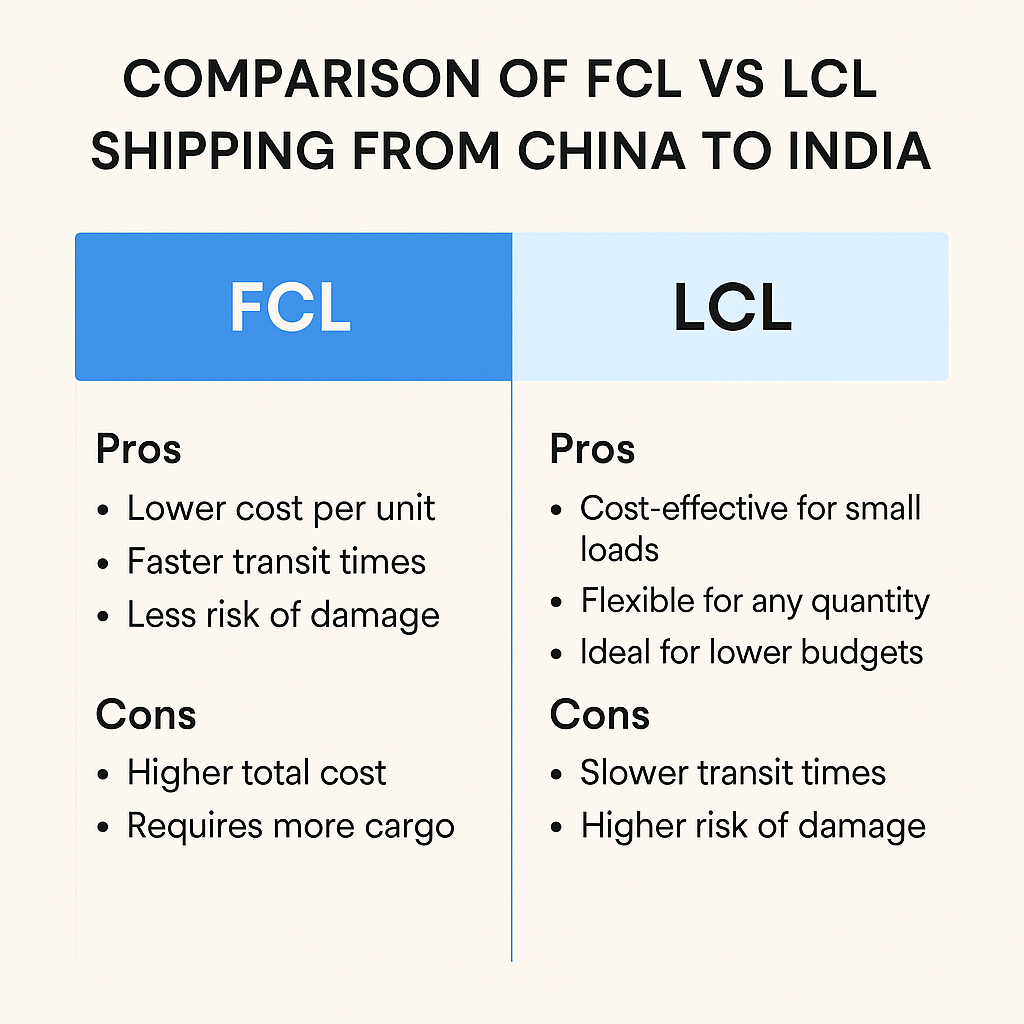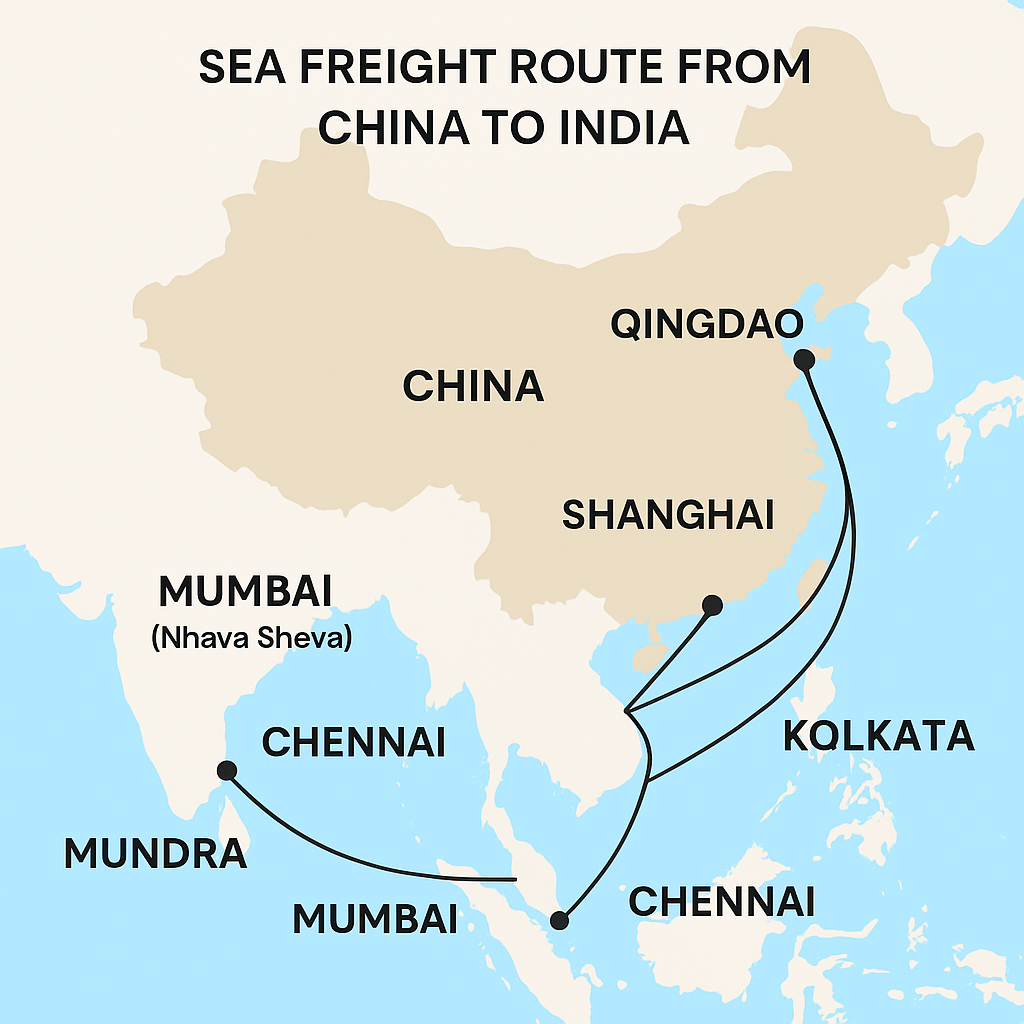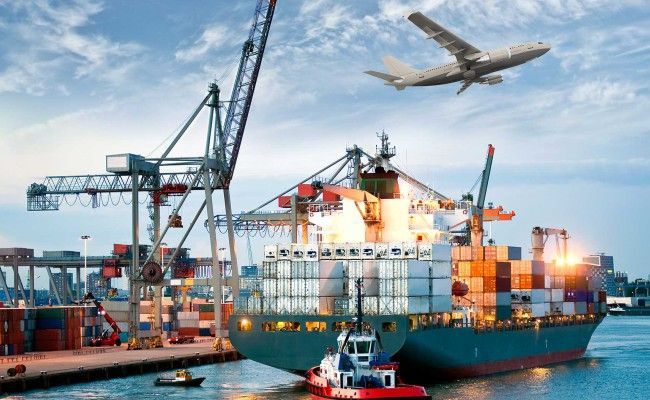- By Della tj
- September 3, 2025
- Sea Freight, Shipping
Shipping between China and India forms one of Asia’s strongest trade corridors. Freight charges from China to India by sea are a critical factor for companies importing bulk goods, machinery, and consumer products. Many importers struggle with fluctuating costs, unpredictable transit times, and complex customs procedures. However, by understanding how sea freight works and applying practical strategies, businesses can ship confidently and save money.
What Are Freight Charges from China to India by Sea?
Freight charges from China to India by sea include all expenses related to transporting goods between ports. They typically consist of:
- Base Ocean Freight – shipping cost per container.
- Terminal Handling Charges – port-related fees.
- Documentation Costs – bills of lading and invoices.
- Fuel Surcharges – bunker adjustment factors.
- Customs Clearance Fees – compliance-related charges.
- Inland Haulage – trucking within India.
Although costs vary month to month, they remain far lower than air freight. In addition, large-scale importers often negotiate lower rates through long-term agreements with carriers.
Why Choose Sea Freight Over Air Freight?
Sea freight dominates trade between China and India because of cost efficiency. While transit times are longer, shipping bulk goods by ocean drastically reduces unit costs.
| Factor | Sea Freight (FCL/LCL) | Air Freight |
|---|---|---|
| Cost per kg/unit | Low (best for bulk) | High (3–5x higher) |
| Transit Time | 15–25 days (average) | 3–7 days |
| Cargo Type | Heavy, bulky, non-urgent | Urgent, fragile, high-value |
| Environmental Impact | Lower per unit | Higher emissions |
| Scalability | Flexible container capacity | Limited by aircraft size |
Accordingly, companies should consider air freight only for urgent or perishable shipments. For most goods, sea freight remains the practical option.

How Much Do Freight Charges from China to India by Sea Cost?
Sea freight rates differ depending on origin, destination, container size, and carrier.
| Container Size | Average Rate (USD) | Suitable Cargo Volume |
|---|---|---|
| 20GP | $1,050 – $1,300 | 28–30 CBM / 22 tons |
| 40GP | $1,900 – $2,300 | 58–60 CBM / 26 tons |
| 40HQ | $2,000 – $2,400 | 68 CBM / 26 tons |
For example, a small shipment under 10 CBM might cost less with LCL, yet once volumes reach 15–18 CBM, FCL is usually cheaper. Moreover, early bookings often provide significant savings.

Which Are the Major Sea Routes Between China and India?
Frequent routes link China’s industrial hubs with India’s primary ports.
| POL (China) | POD (India) | Avg Transit Time | Key Carriers |
|---|---|---|---|
| Shanghai | Nhava Sheva | 18–22 days | COSCO, CMA, ONE |
| Ningbo | Chennai | 20–25 days | MSC, HMM, OOCL |
| Shenzhen | Mundra | 15–20 days | Evergreen, Hapag-Lloyd |
| Qingdao | Kolkata | 22–26 days | Yang Ming, OOCL |
As a result, importers can choose routes based on proximity to factories and distribution centers. On the other hand, certain lanes may require transshipment via Singapore or Colombo, extending transit times.

What Factors Influence Freight Charges?
Several elements directly impact ocean freight rates:
- Container Size & Type – 20GP, 40GP, 40HQ, or reefer units.
- Cargo Weight & Volume – heavier or voluminous goods cost more.
- Fuel Prices – bunker adjustments fluctuate monthly.
- Seasonality – August to November is peak season.
- Port Congestion – delays increase overall charges.
- Incoterms – FOB vs CIF vs DDP alters responsibilities.
In addition, trade imbalances and shipping alliances between major carriers affect long-term pricing stability.
How Long Does Shipping Take?
Transit time depends on both origin and destination.
| Route (China → India) | Avg Transit Time |
|---|---|
| Shanghai → Nhava Sheva | 18–22 days |
| Ningbo → Chennai | 20–25 days |
| Shenzhen → Mundra | 15–20 days |
| Qingdao → Kolkata | 22–26 days |
However, customs inspections, storms, or labor strikes can delay shipments. In addition, congestion at Indian ports may extend clearance times by several days.
What Customs Documents Are Required?
Documentation ensures smooth customs clearance.
| Document | Purpose |
|---|---|
| Bill of Lading (B/L) | Confirms shipment and ownership |
| Commercial Invoice | Declares product value |
| Packing List | Details cargo contents |
| Importer Exporter Code | Mandatory for importers in India |
| Certificate of Origin | Identifies manufacturing country |
| Letter of Credit | Secures payment (if applicable) |
Without a doubt, missing paperwork creates costly delays. Accordingly, businesses should double-check documents before shipment.

How to Reduce Freight Charges from China to India by Sea?
Practical strategies can significantly lower shipping costs:
- Book Early: Advance bookings secure better rates.
- Consolidate Shipments: LCL sharing reduces expenses.
- Negotiate Contracts: Frequent shippers get discounts.
- Select Efficient Ports: Mundra often clears faster than Nhava Sheva.
- Use FOB Terms: Gives flexibility in choosing forwarders.
For example, shifting cargo from Nhava Sheva to Mundra has saved companies both time and money. In addition, ensuring containers are fully utilized avoids wasted space.
Case Studies
Case 1: Electronics Shipment Shenzhen → Mumbai
- Cargo: 40HQ, LED TVs (680 units).
- Unit Value: $250.
- Freight: $1,850.
- Transit: 20 days.
- Result: Saved 20% by shipping one 40HQ instead of two 20GP.
Case 2: Furniture Shipment Ningbo → Chennai
- Cargo: LCL, 12 CBM.
- Freight: $650.
- Transit: 18 days.
- Result: Affordable option for small business importers with limited cargo.
Logistics Trends for China–India Trade
- Digital platforms improving rate transparency.
- Eco-friendly vessels reducing carbon footprint.
- Faster customs clearance via digitization in India.
- Rising bilateral trade volumes boosting container capacity.
Therefore, businesses can expect faster, more transparent, and greener shipping in the near future.
Conclusion
Freight charges from China to India by sea remain the most economical way for bulk shipments. By understanding container costs, transit times, customs duties, and carrier choices, businesses can save money and reduce risks. Moreover, partnering with a professional freight forwarder ensures reliable schedules and smooth clearance. In conclusion, careful planning will lead to more predictable and profitable trade operations.
Request a Quote
Need a tailored solution for your shipping from China?
Let TJ China Freight Forwarder assist you with reliable, cost-effective service.
FAQs
Q1.What is the cheapest way to ship from China to India?
The cheapest option is usually sea freight via FCL. It reduces cost per unit for bulk shipments. Booking early, consolidating orders, and comparing carriers monthly further lower expenses.
Q2.Can small businesses ship less than a container load?
Yes, LCL allows small importers to share space with others. Although handling adds some time, this method is cost-effective for cargo under 15 CBM.
Q3.How are customs duties calculated for imports?
Duties are based on HS code, declared value, and Indian tariff schedules. Typical charges include Basic Customs Duty, IGST, and surcharges. Licensed brokers help ensure accuracy.
Q4.Which ports in India are most efficient?
Nhava Sheva, Mundra, and Chennai are the top entry points for Chinese imports. They offer modern facilities, faster customs, and high container capacity.
Q5.What hidden charges may apply?
Importers should expect terminal handling fees, delivery order charges, and possible demurrage or detention. Checking with forwarders upfront avoids cost surprises.

